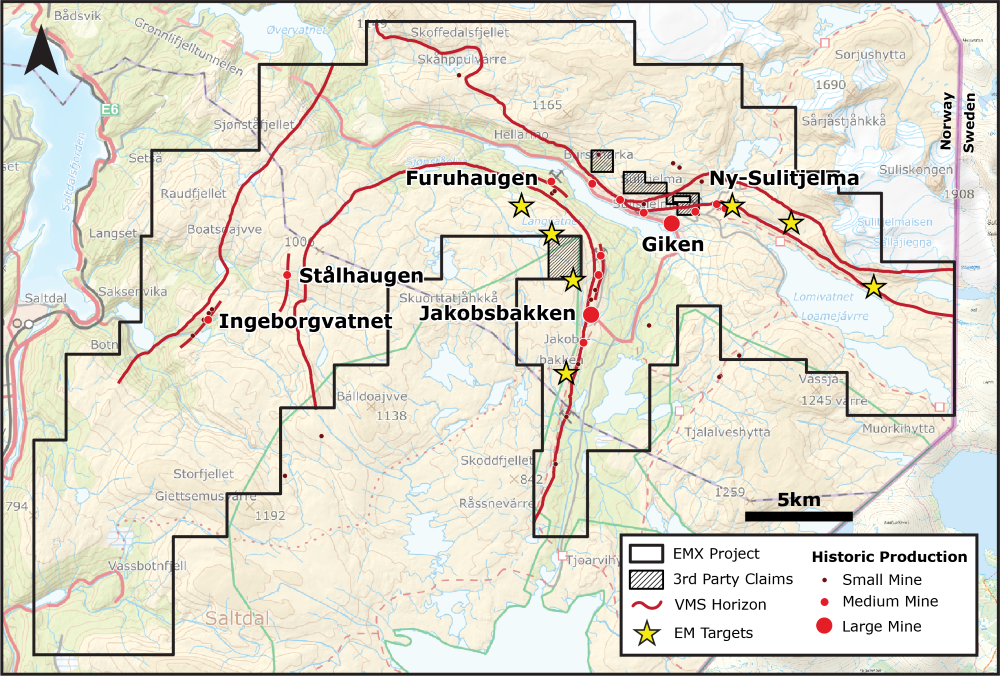Sulitjelma
The Sulitjelma project is a past producer of copper-rich polymetallic mineralization from a cluster of volcanogenic massive sulfide (“VMS”) style deposits in the greater Sulitjelma district of north-central Norway. The Sulitjelma VMS district was discovered in 1858 and was mined continuously from 1891-1991. The Sulitjelma mines were some of the last operating base metal mines in Norway and one of its most significant historic mining areas. VMS style mineralization occurs along a trend that extends for over 20 kilometers and is developed along multiple stratigraphic horizons and structurally repeated sections. The district produced over 25 million tonnes averaging 1.84% copper, 0.86% zinc, 10 grams per tonne silver and 0.25 grams per tonne gold.1 Significant historical resources were left unmined at the time of closure in the early 1990’s.
The mineralization is strata-bound between submarine basalts and overlying Ordivician sediments, comprising the Sulitjelma Ophiolite sequence. These lithologies have been isoclinally folded such that they now appear stacked within stratigraphy, giving the appearance of multiple zones of mineralization. Mineralization is coupled with distinct hydrothermal chlorite alteration which makes identifying additional mineralization recognizable at surface.
Historical hurdles like inefficient processing plant and low copper prices led to closing of the mine in 1991. It is estimated 25 Mt of the historical non-compliant resources of 35 Mt was mined from the Sulitjelma district.2 The district has seen very little work since the mines closed. Reinterpretation of airborne geophysical surveys, including a Versatile Time Domain Electromagnetics (VTEM) survey collected in 2014, highlighted multiple conductive anomalies along the main trend of mineralization that have not yet been drill tested, and EMX geologists have found outcropping expressions of VMS style mineralization, also along trend, that have not been developed or drill tested.
Over the past few years EMX has compiled and digitized the available historical data to create 3D models of the historical mine workings on the property. EMX also conducted extensive soil sampling campaigns and identified drill targets for the next phase of exploration. These targets include projections of mineralization down dip and along strike of the historic mine workings as well as newly identified electromagnetic (“EM”) anomalies. Additionally, EMX recognized that the VMS horizon appears to be repeated in fold limbs to the west of the original property position, which has since been expanded.
On August 8, 2024 EMX executed an agreement to sell its Sulitjelma VMS project in Norway to Alpha Future Funds S.C.S (“Alpha”), a private Luxembourg based company (see EMX news release dated August 8, 2024). The agreement provides EMX with a cash payment and work commitments during a one-year option period, and upon exercise of the option, EMX will receive additional deferred option payments, advance royalty payments, milestone payments and a 2% NSR royalty.
1 Historic production values quoted above are from the Geological Survey of Norway (NGU) Ore Database, Deposit Area 1841-024, Dec 18, 2017.
2 Cook, 1990, et al. The Geology of the Sulitjelma Ore Field, Northern Norway- Some new Interpretations.
*Nearby mines and deposits provide context for the project, but do not necessarily indicate similar size, styles or grade of mineralization within the project.
Maps
Photos

 Click to Enlarge
Click to Enlarge